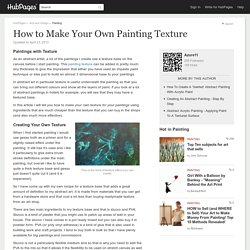

Tips for Painting Water and Reflections. Recently, a Fine Art Tips reader asked me to share some tips for painting water and the sun reflections at sunset.

Like many, this new painter has been a bit intimidated by depicting reflected light on water. Painting water is a fairly complex subject. Water, is affected by its surroundings, reflections, depth and clarity. The painting of oceans, rivers, lakes and ponds can be beautiful, but managing to get the water and reflections to look like actual water can be challenging. Make Your Own Texture - Painting Texture. If you can make your own texture then this is one of the key things that abstract artists in particular want to do to get a thick base on which to work.

None of the readymade textures cut it for me to be thick enough so that is why I came up with my own recipe for painting texture. It can be quite cost effective to make your own texture for use in your paintings or other artwork. If you are going to do this then often you will need to buy the products in large quantities and so this is perhaps for you if you plan on doing a lot of painting and have done quite a bit of texture painting before. However, don’t let this put you off making your own texture as it is always good to experiment with new things in art so a bit of trial and error is always good! How to Add Incredibly Thick Texture to your Acrylic Paintings. Artists who sell original work will (in a sense) always be competing with the seemingly inexhaustible print market.

Luckily for us, discriminating collectors appreciate the unique surfaces that signify a work is an original. That’s the main reason why I like to give my paintings a lot of texture: so everyone can immediately see that they’re originals. The following paragraphs explain my three-step process for adding unbelievable texture to any acrylic painting. There’s only one secret—the texture comes first. Homemade texture paste.
If you are like me you would like to have all kinds of arty goodness in the house but sometimes funds aren't always available or you could use the money for more important things like food or clothing.

I am going to show you something I just made myself. I tried to research it a bit on the web but didn't find anything that I already had on hand to make what I wanted. Texture paste. How to Make Your Own Painting Texture. When I first started painting I would use gesso both as a primer and for a slightly raised effect under the painting.

It still has it's uses and I like it particularly to give extra brush stroke definitions under the main painting, but overall i like to have quite a thick texture base and gesso just doesn't quite cut it (and it is expensive!). So I have come up with my own recipe for a texture base that adds a great amount of definition to my abstract art. It is made from materials that you can get from a hardware store and that cost a lot less than buying readymade texture from an art shop. There are two main ingredients to my texture base and that is stucco and PVA. How To Resolve Question - Making Your Own Texture Paste!